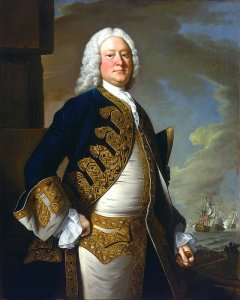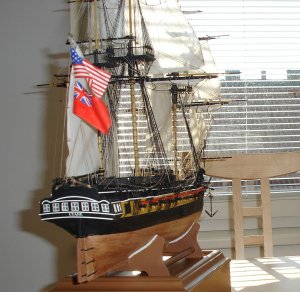Today in Naval History - Naval / Maritime Events in History
6th of August
some of the events you will find here,
please use the following link where you will find more details and all other events of this day .....
1622 – Birth of Tjerk Hiddes de Vries, Dutch admiral (d. 1666)
Tjerk Hiddes de Vries (Sexbierum, 6 August 1622 - Flushing, 6 August 1666) was a naval hero and Dutch admiral from the seventeenth century. The French, who could not pronounce his name, called him Kiërkides. His name was also given as Tsjerk, Tierck or Tjerck.
During the Second Anglo-Dutch War Tjerk was appointed full captain on 27 March 1665. He commanded d' Elff Steden in the Battle of Lowestoft, managing with great personal courage to free his ship from an entanglement with several other burning Dutch vessels, set alight by an English fireship. This fight was a severe defeat for the Dutch and those who by their bravery set a contrast to the general incompetence shown during the battle, were hailed as heroes by the populace. Tjerk in a written report severely criticised his fallen supreme commander Van Obdam. The Frisian admiralty board, in need to replace the also killed Lieutenant-Admiral of the Frisian fleet, Auke Stellingwerf, and sensing the public mood, appointed Tjerk Lieutenant-Admiral of Frisia on 29 June 1665. He thus jumped two ranks, not an uncommon occurrence for the Dutch navy in that century.
Normally the Frisian fleet was rather small, but in view of the emergency the province made a strong war effort, building 28 new vessels, Tjerk supervising the formation of the strongest naval force Frisia would ever send out..........

1789 – Launch of Minerve class 40-gun frigate Melpomène of the French Navy,
sistership:

Scale: 1:48. Plan showing the body plans with stern board outline and some detail, sheer lines with inboard details and figurehead, and longitudinal half-breadth for Princess Charlotte (captured 1799), a captured French Frigate, after being fitted for a 38-gun Fifth Rate, Frigate.
Collections - National Maritime Museum
1808 – Launch of French Clorinde , a 40-gun Pallas-class frigate of the French Navy, designed by Sané. The British Royal Navy captured her in 1814 and renamed her HMS Aurora. After 19 years as a coal hulk she was broken up in 1851.

Hand-coloured etching and aquatint showing HMS Eurotas in action with La Clorinde (1808). La Clorinde is shown on the left. She was captured the day after the action by the Dryad and Achates.

6th of August
some of the events you will find here,
please use the following link where you will find more details and all other events of this day .....
Naval/Maritime History - 6th of August - Today in Naval History - Naval / Maritime Events in History
3 August 1918 - hospital ship HMAT Warilda was torpedoed by the German submarine and sunk HMAT Warilda (His Majesty's Australian Transport) was a 7713-ton vessel, built by William Beardmore and Company in Glasgow as the SS Warilda for the Adelaide Steamship Company. She was designed for the...
shipsofscale.com
1622 – Birth of Tjerk Hiddes de Vries, Dutch admiral (d. 1666)
Tjerk Hiddes de Vries (Sexbierum, 6 August 1622 - Flushing, 6 August 1666) was a naval hero and Dutch admiral from the seventeenth century. The French, who could not pronounce his name, called him Kiërkides. His name was also given as Tsjerk, Tierck or Tjerck.
During the Second Anglo-Dutch War Tjerk was appointed full captain on 27 March 1665. He commanded d' Elff Steden in the Battle of Lowestoft, managing with great personal courage to free his ship from an entanglement with several other burning Dutch vessels, set alight by an English fireship. This fight was a severe defeat for the Dutch and those who by their bravery set a contrast to the general incompetence shown during the battle, were hailed as heroes by the populace. Tjerk in a written report severely criticised his fallen supreme commander Van Obdam. The Frisian admiralty board, in need to replace the also killed Lieutenant-Admiral of the Frisian fleet, Auke Stellingwerf, and sensing the public mood, appointed Tjerk Lieutenant-Admiral of Frisia on 29 June 1665. He thus jumped two ranks, not an uncommon occurrence for the Dutch navy in that century.
Normally the Frisian fleet was rather small, but in view of the emergency the province made a strong war effort, building 28 new vessels, Tjerk supervising the formation of the strongest naval force Frisia would ever send out..........

1789 – Launch of Minerve class 40-gun frigate Melpomène of the French Navy,
sistership:
Scale: 1:48. Plan showing the body plans with stern board outline and some detail, sheer lines with inboard details and figurehead, and longitudinal half-breadth for Princess Charlotte (captured 1799), a captured French Frigate, after being fitted for a 38-gun Fifth Rate, Frigate.
Collections - National Maritime Museum
1808 – Launch of French Clorinde , a 40-gun Pallas-class frigate of the French Navy, designed by Sané. The British Royal Navy captured her in 1814 and renamed her HMS Aurora. After 19 years as a coal hulk she was broken up in 1851.
Hand-coloured etching and aquatint showing HMS Eurotas in action with La Clorinde (1808). La Clorinde is shown on the left. She was captured the day after the action by the Dryad and Achates.




